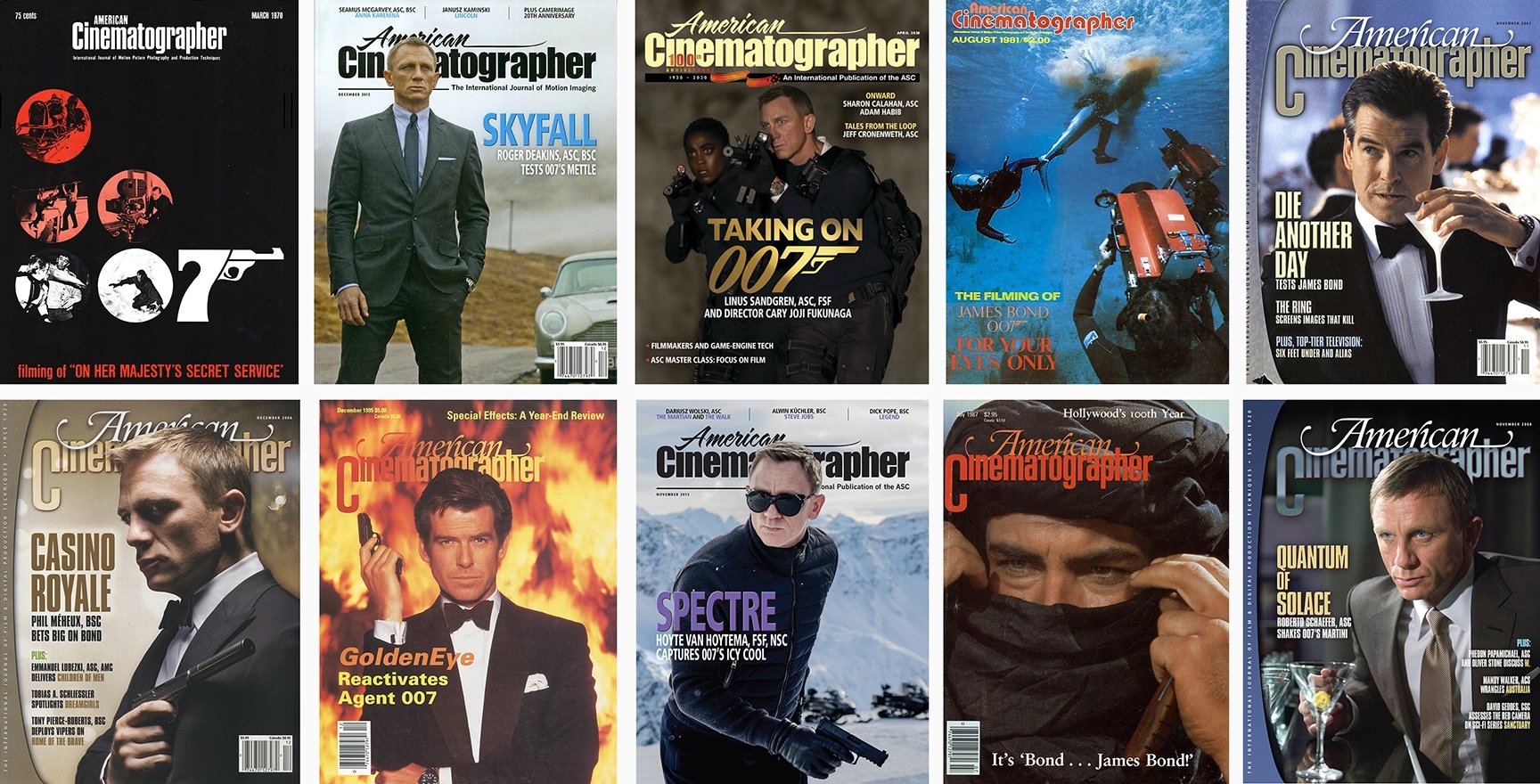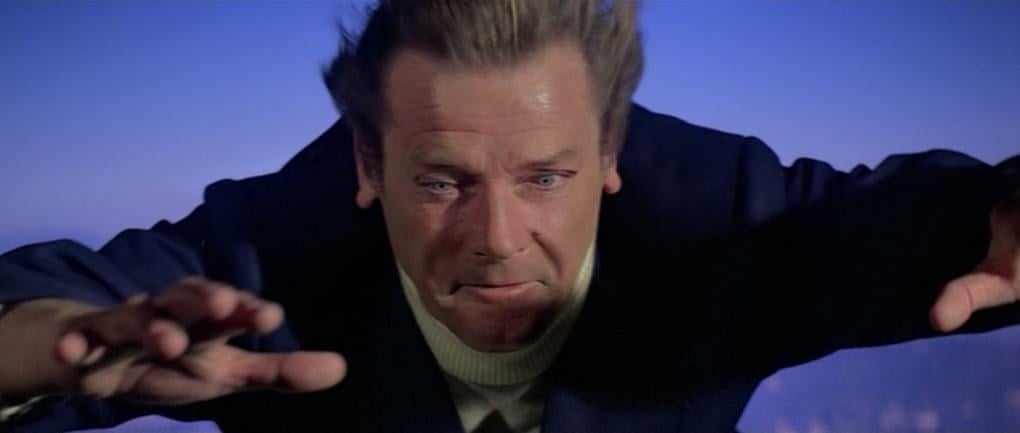
The Freefall Filmmaking of Moonraker
In an effort to create the most spectacular opening sequence for the latest James Bond film, skydiving daredevils take to the air.
Editor’s note: The author was the aerial parachute photographer on Moonraker.
They said it couldn’t be done. The Spy Who Loved Me touted “the most spectacular opening sequence ever filmed” and many doubted that it could be topped.
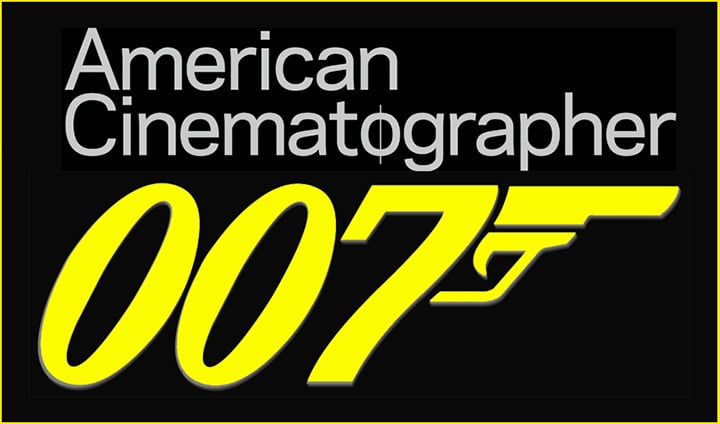
In July of 1977, my partner, B.J. Worth, and I began discussing the capabilities of freefalling skydivers; what could be staged, and filmed, which might put Moonraker’s opening one step better. We weren’t fully aware of what was to come. Some of our past work was viewed again and several ideas came to light. Our initial reaction — it might just work! Since we still had reservations, a step-by-step test program was begun to afford us the best possible results.
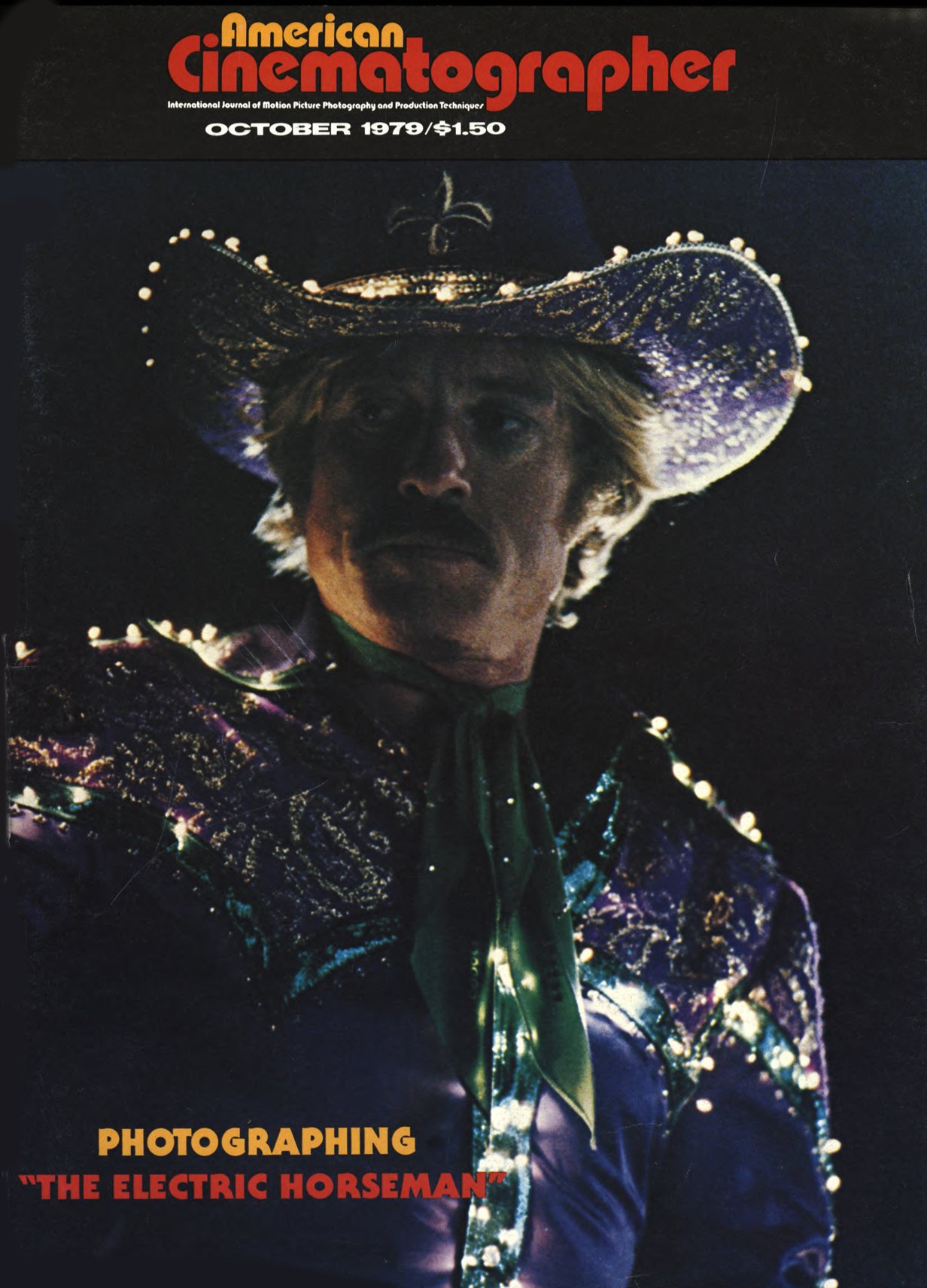
B.J. started making arrangements for the jumpers (doubles for Bond, Jake Lombard, and for Jaws, Ron Luginbill, and the necessary equipment. As my specialty is freefall cinematography, I got to determine and produce the camera system which would be used in freefall and yield the quality expected in a 35mm production with a 2.35:1 format. I started running.
Practically speaking, a freefalling cameraman is limited to a total helmet weight of 12-15 pounds maximum. Multiply that by an opening force of 2-3 G’s (higher in the event of using the “reserve” or emergency parachute) and you begin to see the problem (if not stars). A 30mm Panavision lens weighs 6½ pounds—not much left for the camera.
The Eyemo was the only 35mm camera I knew of which came close for size and weight; however, some of our other requirements might negate its use.
I began calling lens and camera manufacturers, optical engineers, underwater specialists, anyone I could think of. I wanted all the information available on 16mm anamorphic lenses or attachments, lightweight 35mm cameras, and 35mm anamorphic lenses which might be an alternative to the heavier, but common, systems. Every answer drew the same conclusion: optimum results required 35mm anamorphic format, and no single system combined the size, weight, frame rate and reliability requirements set forth.
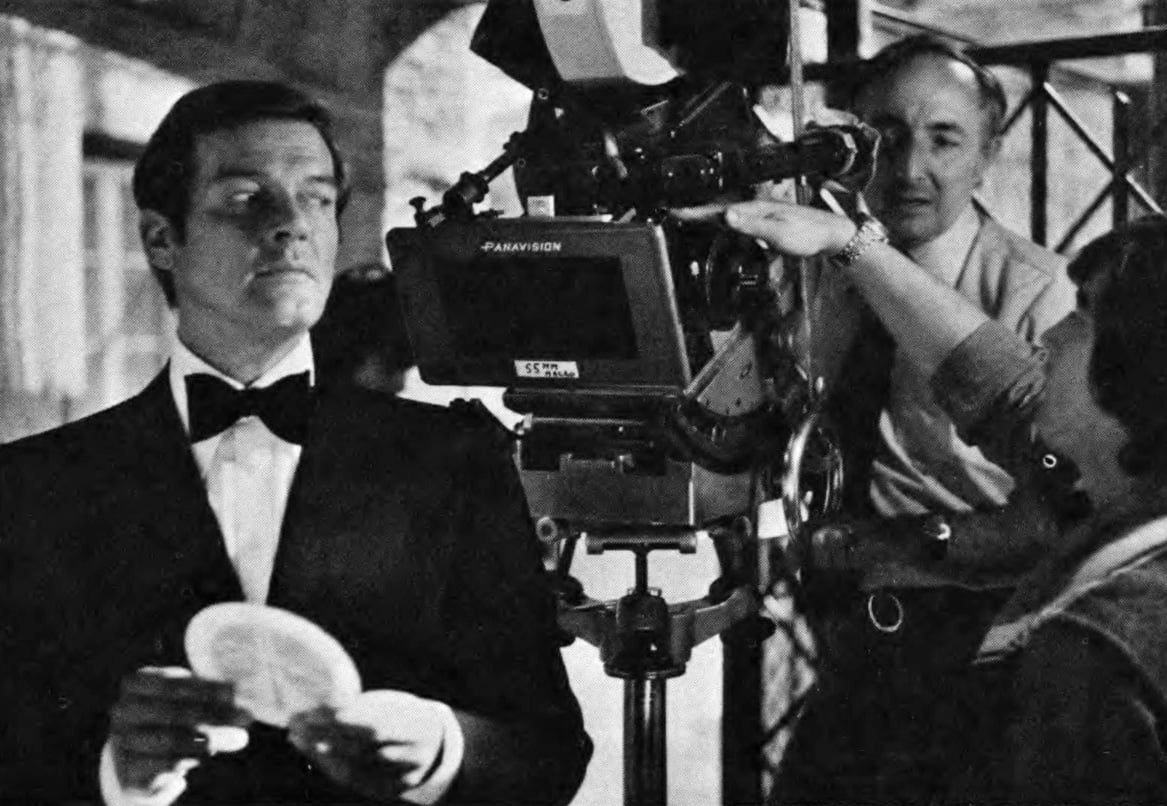
spectacular set design, incredible vehicles and fascinating gimmicks in an irresistible mix. Nobody seems to notice (or care) that the plot is always the same: Bond confronting a megalomaniac billionaire who wants to take over the world, or, in the case of Moonraker, the universe.
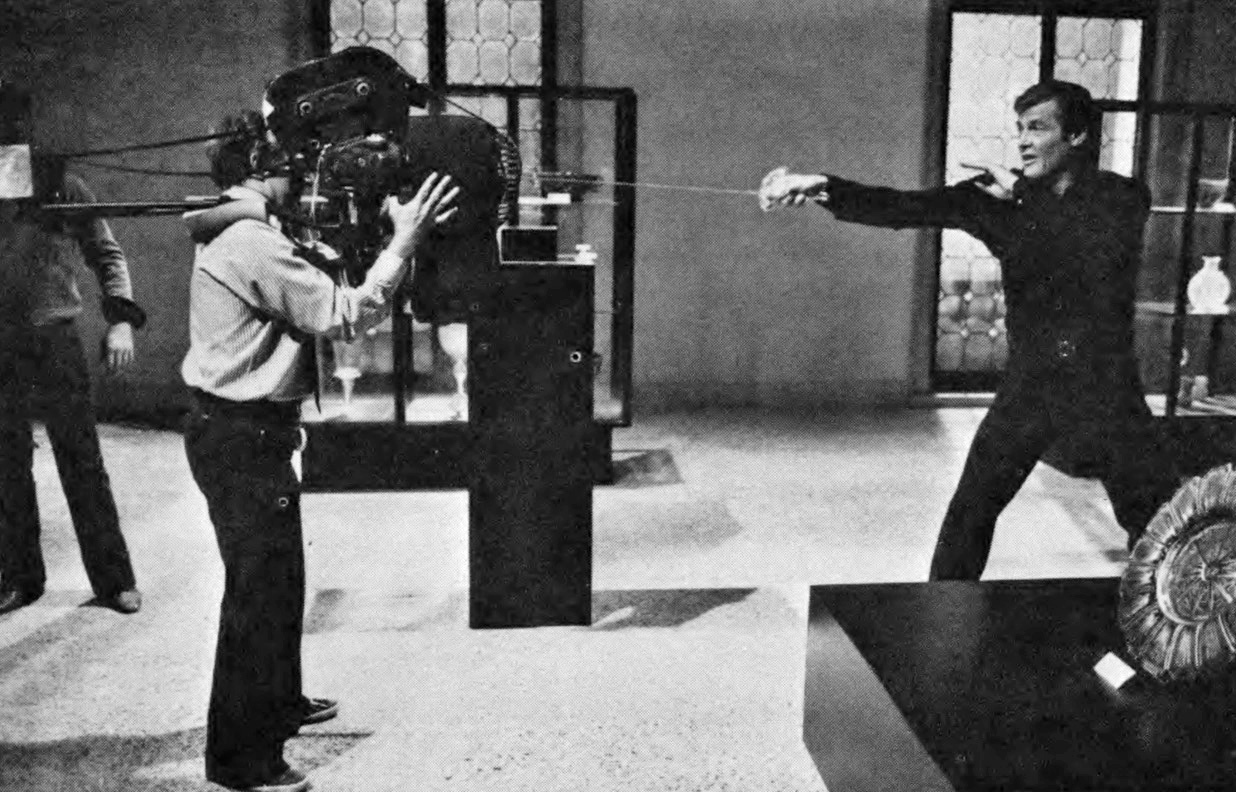
Our first test was filmed using my own Photosonics 1VN — a high-speed, pin-registered 16mm photo-instrumentation camera — the reason being that some of the shots we discussed might require high frame rates, and the 1VN will run up to 200 fps. We knew that enlargement of the film would compromise the quality, but it might have to be done anyway. Also, on the test, the results of the action were more important than the format. We did have this piece of film optically enlarged, with the obvious results — adequate, but we had to find a suitable 35mm system.
The second test evolved around the Eyemo 35mm camera. This unit weighs in at about 6½-7 pounds without a lens — which was about the maximum I would care to jump, once film and lenses were added. For the test jumps, I adapted my existing helmet to fit the Eyemo and used a spherical lens, (a) to see if we could live with optically enlarging and cutting off the frame to 2.35:1, and (b) in the interest of saving weight and keeping the mount simple for the test. Since my preference is for the camera to be mounted on top of, rather than on the side of the helmet, some modification of the existing mount was necessary; I also had to become accustomed to the extra foot I had “grown” over my normal cameras. This became most noticeable when I wanted to move about in the already-cramped Cessna 180 or get out of the 4'-tall door. I wasn’t terribly comfortable with the size and bulk of the Eyemo and didn’t look forward to jumping one with an anamorphic lens. If we shot in full-frame or academy, we would still suffer an unwanted loss when going to the 2.35:1 format. Too, I wanted the availability of higher frame rates together with a more rugged pressure plate design. What to do?
About that time, I read the article in American Cinematographer on the filming of Capricorn One (AC, Dec. '77) and noticed (1) Dave Nowell, the author, was a long-lost college buddy, and (2) Continental Camera of Los Angeles had a 35mm “P.O.V. Camera.” After a telephone reunion with Dave, he turned me over to John Carroll, who told me about the camera. Freddie Waugh, a stuntman, and Al Beck of Cine Mechanics had designed and built a 4½ pound (without lens) 35mm camera which had a 100' daylight-load capacity and would run a reliable 48 fps with no floating of film in the gate. It had already been helmet-mounted for stunt work. Somehow, it took two months of inquiries to find out that the Panavision lenses could be adapted to the Arrimount P.O.V. camera. After discussing the situation with John Carroll, he agreed to let me test-jump the camera. The conditions: mount the camera and lens so that each were supported totally and independently, as the lens mount would not support an anamorphic optic during a parachute deployment; and don’t break the camera.
To ready the P.O.V. camera for jumping, Dave and I took it back to Al Beck, who modified the lens mount to ensure proper alignment. We then designed a very basic mount that would suffice for the test. In a couple of days, Don Taylor of D&E Industries gave us a strong, lightweight alloy mount on a new helmet. The subsequent test was a culmination of everyone’s efforts. The specially-built parachute systems, the camera, the personnel — we had come up with the necessary combination for filming the opening to Moonraker.
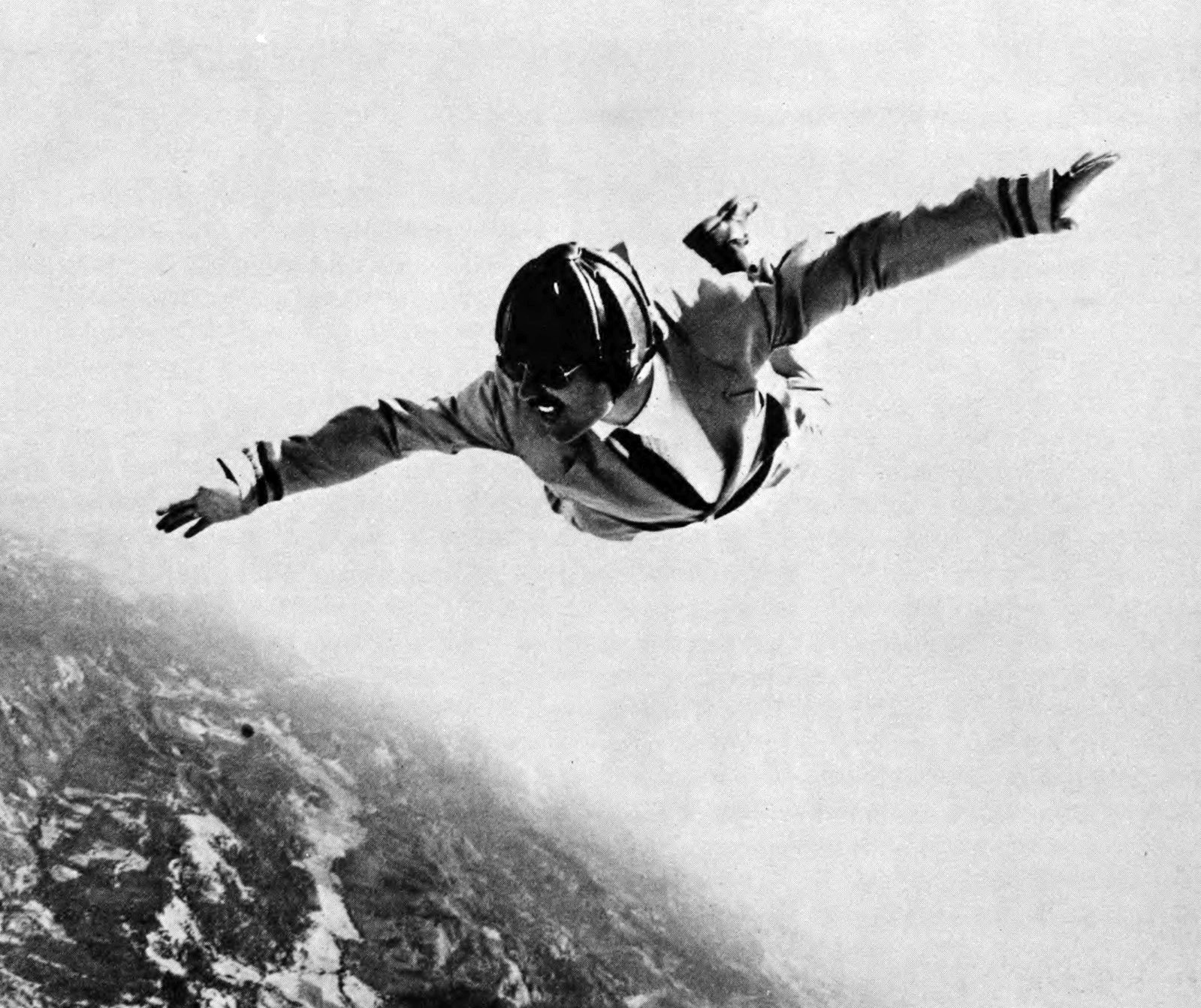
specially designed suits contain both main and reserve parachutes and were reinforced to withstand freefall flights and landings. (Photo by Peter Boettgenbach.)
Ten months after we had come up with our first idea, the “skydiving unit” gathered together to film what was to become the “Big Sky Sequence” — a fight in freefall between James Bond and his adversary over a single parachute — winner takes all. The helmet mount had been replaced by a new, stronger one which would break down easily and support a variety of Panavision lenses for the 90 to 100 jumps we estimated to be necessary. Extra batteries, chargers, and wiring systems (leading to a hand-activated switch) were supplied as back-ups, all as requested. The total system weight (helmet included) was 12½ pounds, which required a parachute with slow, consistent openings. The reefing-line deployment system on Para-Flite, Inc.’s Strato-Star was of major importance in keeping me in the air. On the first day of filming, on our fourth jump, we all became overly involved with the action and opened very close to each other. My attention was diverted, I didn’t brace for opening shock and badly wrenched my neck. Any other parachute opening system would have ended my career. After a weekend of hot springs and hydrotherapy, we began again. Due to this incident, we felt that a standby cameraman would be a good idea. Peter Boettgenbach, a German parachutist/photographer, was immediately available and filled the position. He also provided some excellent production stills.
The staging and filming of the entire sequence proved to be quite educational... and challenging! According to the storyboard which had been drawn up, eighty-four separate scenes would be required; and about 85% of these would be air-to-air shots.
Freefall is perhaps a cameraman’s most limiting environment. Aperture, frame rate, and depth-of-field must be pre-set, then left alone during the jump. Sighting must be aligned on the ground; the Newton Ring-Sight provides reference only to the center of the frame. Composition and framing is by experience (trial and error, and luck, in some cases).
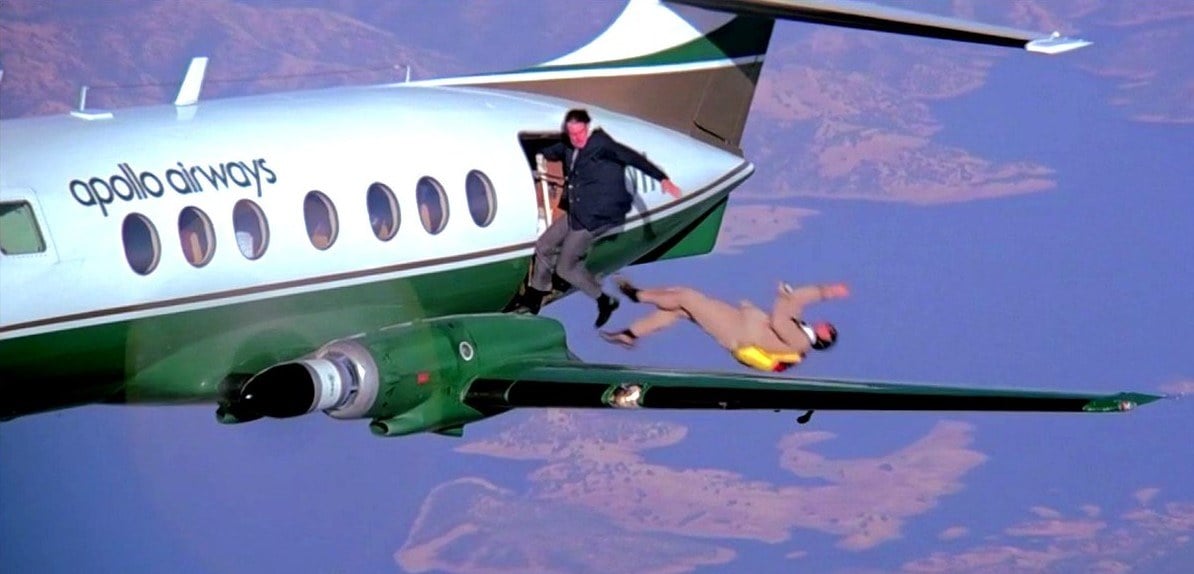
In the movie, when James Bond initially leaves the airplane, the scene called for the plane banking away out of control and leaving frame to the side. The speed and angle at which we exited, my distance from “Bond” and the width of the frame called for accurate timing of our exits with respect to each other and to the aircraft. To get the desired effect, the pilot had to start a bank in the direction opposite to what we needed. As he reversed direction of roll, momentum picked up, and we let go as the aircraft passed 50° to 60° of the bank. The result was just as hoped for — Bond, out of control, without a parachute, falling away from a doomed plane.
Film capacity and frame rate limited us as well. Much of the action was occurring so fast that a higher frame rate was necessary to get “normal” motion on the screen. Therefore, camera running time was limited to about 35 seconds. That was minor, compared to staying with my subjects. Following two jumpers who were “fighting” was quite a task, since their rate of fall was much faster than your average skydiver or group. The problem was compounded by their use of business suits in place of regular jumpsuits, which resulted in exaggerated speed and an overall decrease in control. They tended to move about in a very rapid and erratic manner. Following them, remaining a somewhat stable camera platform and taking into account sun angle, lens size, depth-of-field, composition and background proved even more interesting. The available freefall time in most cases allowed for the set-up, one try at the action and separation from each other for opening; no rehearsals, minimal extra time. At least the weather was incur favor; lighting conditions were fairly constant during the hours we set aside to film — late morning through early afternoon.
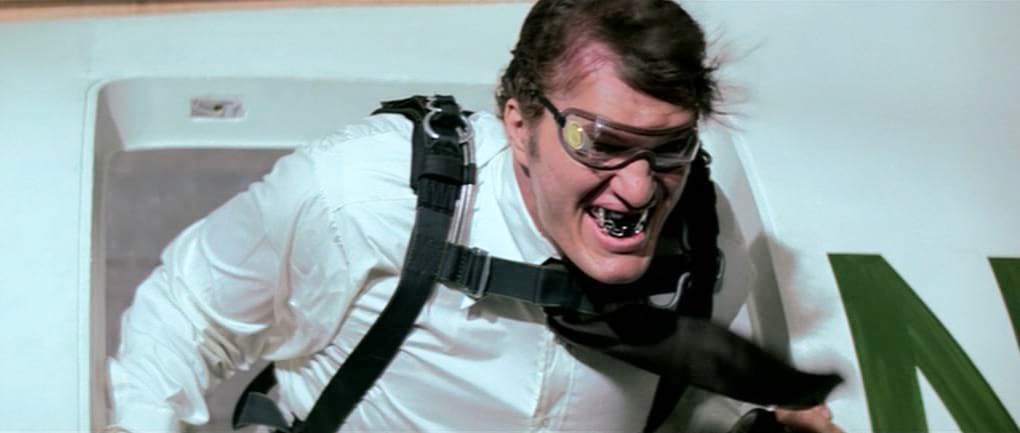
As we all adjusted to the situation, the number of jumps increased to an average of five per day. One by one the successful takes were set aside and I found myself jumping a different lens and position each time. This meant changing the lens, sight alignment, and frame rate for every jump. Each point of view required a change in flying techniques, as well — once or twice that technique was just to hang onto the jumpers’ feet or arms! Eventually, everyone became more adept at keeping the fight in front of the camera, although I still spent much of my freefall time in a vertical dive.
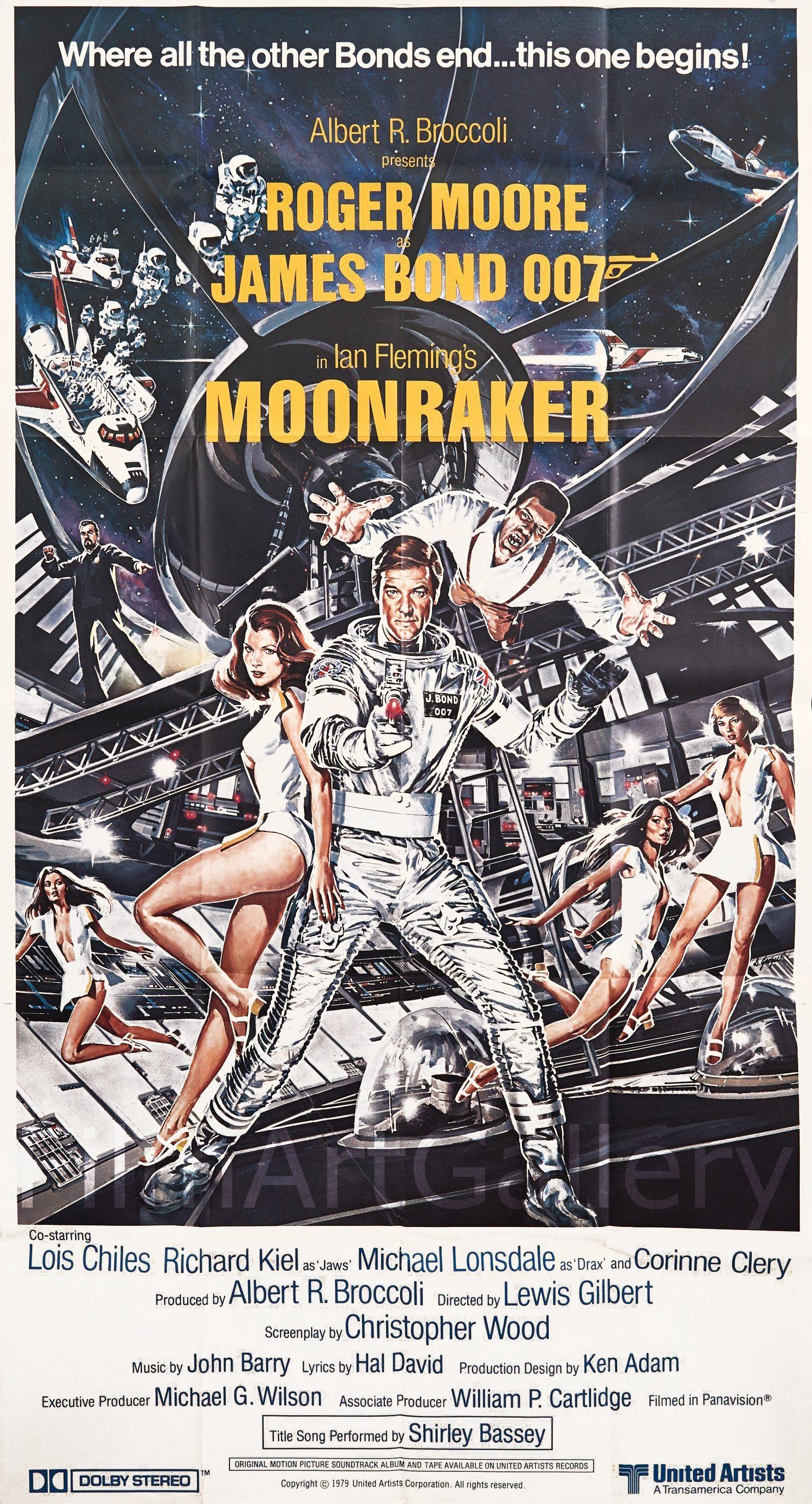
Because the location of the drop zone was a bit removed from the “big city,” we had made arrangements for a portable projector and a widescreen. Dailies provided a great source of entertainment, as well as being our greatest single critic.
Five weeks after our arrival, I had made 76 camera jumps and my neck was almost back to normal — size 18 (it used to be 15½). We had about 25 minutes of film “in the can” which would eventually become about three minutes — not a bad ratio for the type of sequence undertaken. Very little film was shot at a normal frame rate, and the only lenses used were the 30mm and 40mm Panavisions — 50mm and larger had led to difficulties following the action with any degree of steadiness.
Camera assistant Phil Pastuhov had done an excellent job of caring for and readying the camera between jumps — as a result, we came through without a single frame of scratched negative (the conditions were extremely dusty the entire time). Continental’s camera performed flawlessly, even at the highest frame rates. Though all concerned would like to have started again at that point to go it one better, we had come a long way and were satisfied with the results.
As though to end it all on a warning note, my last jump was solo to film some plates — after 60 seconds of freefall, I deployed my canopy... and was looking straight into the door of another Cessna on jump run, which had missed me by about 30'.
It never gets boring.
This short documentary further details the creation of the sequence, narrated by 007 franchise producer Michael G. Wilson:
DeLuca would subsequently work on the 007 adventure Octopussy.
